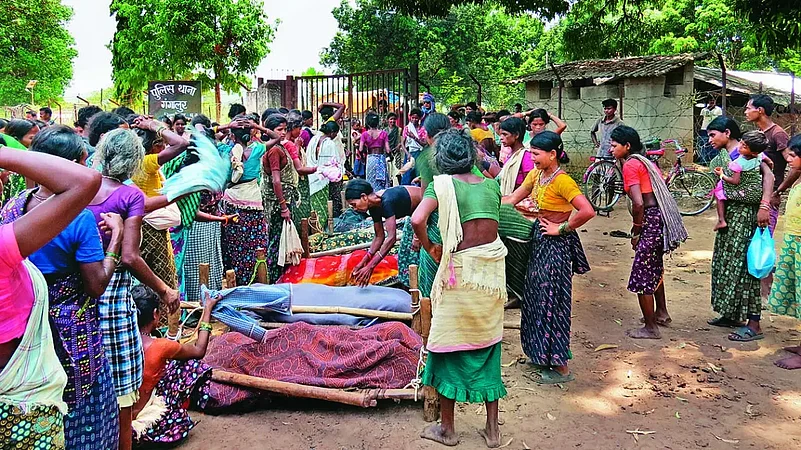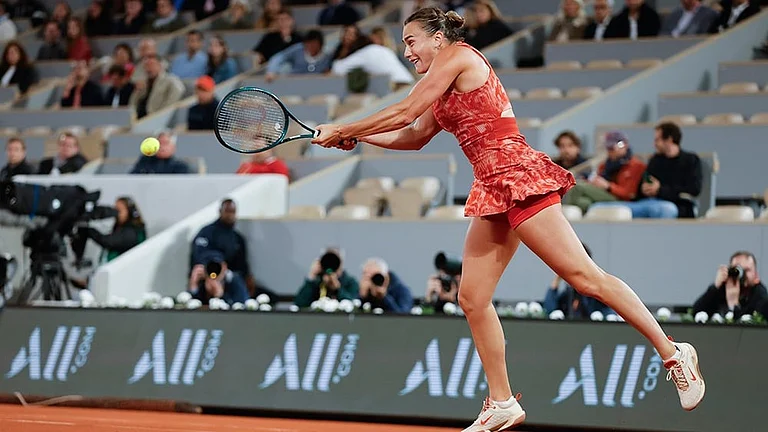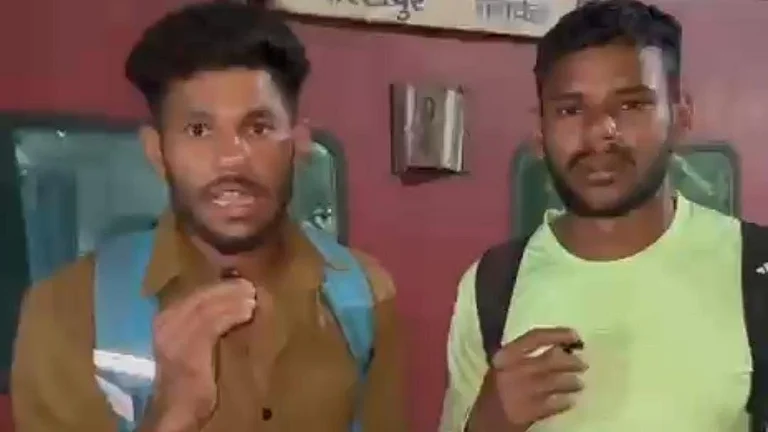Right across the Kutru police station in Bijapur district of south Bastar in Chhattisgarh, stands the first Salwa Judum memorial: Salwa Judum Shahid Smarak. Many Salutes to the Martyrs - June 4, 2005.
On that day, the Chhattisgarh government signed a highly-publicised MoU with the Tatas for an ultra-mega steel plant in Bastar. A day later, the Salwa Judum was launched to evict Maoists from the region—a move that began a series of encounter killings that would redefine the landscape and history of Dandakaranya. Whether retributive or executed in rage or under the shield of law—by security forces or by the Maoists—the common denominator of all these killings was that the finger on the trigger acted with utmost impunity. Obviously then, the perpetrators were rarely punished and justice eluded the victims.
In the 30 months of the Judum campaign, Chhattisgarh saw the death of 325 security personnel, 609 civilians and 165 suspected Maoists—1,099 killings, or one a day. And these are the official figures. Judum leaders and local police place this number far higher. The killings didn’t stop with the Judum, as the cycle of violence continued unabated for the next 10 years.
What made the Judum a dark chapter in the history of anti-insurgency operations in India was that it pitted Adivasis against their own brethren, as, on the pretext of eliminating Maoists, the state government handed over weapons to Adivasi boys for whom it became a sport to settle scores with their neighbourhood rivals.
The Judum campaign ended in 2007 after massive protests from activists. Also, the Chhattisgarh government had drawn enough criticism from various sections of society, and its funding of Judum leaders had become increasingly untenable. But the gun-carrying youth, known as Special Police Officers (SPOs), continued to use weapons against their own community. While the Supreme Court eventually declared the SPOs illegal in July 2011, the state government soon re-inducted them by rechristening them as auxiliary constables. The culture of rifles among Adivasis, aided by the ever-increasing deployment of paramilitary forces, has permanently mutated the central Indian forests. The gore and violence the jungle has witnessed is accompanied with falsehood and treacheries.
Consider these instances. A 16-year-old tribal girl was killed by police in a “Maoist encounter” in the remote village, Karcha, of Surguja district on July 6, 2011. While the villagers said she was raped and murdered by police, the latter termed her a Maoist. While the police said intense firing went on for hours as they faced a large group of Maoists, only her body was found at the spot. After the post-mortem report confirmed injuries in her private parts and semen on her clothes, the government tried to tarnish the reputation of the minor. “First, they (police) raped and killed her, then termed her a Maoist and now call my daughter a slut. It hurts the most,” her father had then told this correspondent. After heavy protests by villagers, a long ordeal of probe commission and court trial began. The inquiry commission submitted its report in 2015 and rejected the police version that she was a Maoist. It even noted that her injuries suggested “forced sexual intercourse with her”.
However, it still didn’t ensure justice to the deceased girl. In May this year, a Raipur court acquitted the accused policemen by noting that while there was ample suspicion, “improper investigation” led to weak evidence.

There have also been cases when the judicial commission indicted the security forces, but there has been no police case or court trial yet. One can count two near-similar encounters in Bijapur district in quick succession that rocked the state as well as the home ministry. While 17 Adivasis were killed in CRPF firing at Sarkeguda village in June 2012, eight Adivasis were killed in Ehadsameta village in May 2013. In both cases, security forces opened fire at a gathering of Adivasis, claiming that they were Maoists. Two separate commissions were formed to probe the incidents, both headed by Justice V.K. Agrawal. The court hearing took place at Jagdalpur—a daylong journey of over 200 km from the villages.
ALSO READ: Fake Encounters In India: Laws, Flaws & Fear
While the Sarkeguda report was submitted in 2019, the Ehadsameta report was placed before the assembly this year. In both cases, the commission rejected the State’s claim and said all the deceased were Adivasis, and that the security personnel did not fire in self-defence but in haste.
Consider the brutality of the Sarkeguda incident—several deceased had dagger wounds on their bodies, indicating that the security forces had not fired at them from a distance but stabbed them from close. The killings shocked the country after the Chhattisgarh police termed it the “biggest Maoist encounter”, and the then Union home minister P. Chidambaram stated that three of those killed were important Maoists—Mahesh, Nagesh and Somulu. But there was no Mahesh among the deceased, and the person the police named Somulu was actually Dinesh. There were two Nageshs, a class topper of 15 years and a 32-year-old man who played dholak at village festivals. The latter had two children and his wife Shammi was pregnant with a third. “Do you know of any Maoist who plays the dholak? If he were a Maoist, would he have played the dholak at weddings?” his sister Sushila asked.
The deceased included a girl of 12 years and two bright students of Class X, Kaka Nagesh and Madkam Ramvilas, who studied in a government school and were among select students the education department had taken on a trip to Visakhapatnam earlier that year. Nagesh was good at math. His command over the subject caused his death. He had been especially called for the assembly of the Beej Pundum festival on the night of the killings to calculate the possible expenditure the Adivasi festival would entail.
If in Sarkeguda the forces had only stabbed the Adivasis, the Ehadsameta encounter witnessed mutilation of bodies. On May 19, 2013, eight corpses were lying under the merciless sun in the jungle. On May 17, the forces fired at a gathering for Beej Pundum. Among the deceased were Karam Joga and his 13-year-old son Badru, along with Karam Pandu and his 14-year-old son Guddu. But the grief was not yet over. The families were waiting to receive the bodies, which were lying in an open field for a mandatory post-mortem, decomposing, badly swollen and releasing an unbearable smell. CRPF men, faces covered, guarded them with X-95 and AK-47 rifles.
“Jara pet par chira laga (cut the stomach open),” government doctor B.R. Pujari said. His face was covered. Suklu, an Adivasi, came forward and cut open a naked body. Red worms protruded out from the stomach with a burst of gas. “Dead bodies become like balloons. When you cut them open, they produce a sound like flatulence,” a CRPF soldier explained. As relatives held the corpses and turned them sideways and upside down, the doctor examined them, poking and prodding with a twig he had picked up from the ground, and made a record in his register.
Suklu, in his torn green vest and blue underpants, made several incisions in five corpses with two blades. Without changing gloves, he slit open bodies, inserted his hand into the stomachs, pulled out the innards to enable the doctor’s examination, before shoving them inside again. The villagers watched the public spectacle of their relatives’ bodies.
A post-mortem of people killed in firing by the security forces, the law mandates, must be conducted by two doctors in a district hospital.
There is another kind of encounter, that of the guerrillas. The Maoists saw two of their topmost leaders getting killed in a span of 15 months that broke the back of the insurgents. While their Central Committee spokesperson Cherukuri Rajkumar alias Azad was killed in July 2010 in Andhra Pradesh, Politburo member Mallojula Koteshwara Rao alias Kishenji, was killed in November 2011 in West Bengal. Significantly, the negotiations between the CPI(Maoist) and the Indian government were underway when Rajkumar, the insurgent’s emissary, was killed in the forests of Adilabad. The Maoists couldn’t recover from the loss.
And then there are retributive killings by the Maoists. They have often killed both their comrades as well as Adivasis on the suspicion of being police informers. They hold Jan Adalats—kangaroo courts—which may see the accused being stoned to death. The Maoists executed Modiyan Badru, a former member of their West Bastar Division Committee, in a Jan Adalat in September 2020. Around that time, the Maoists killed over two dozen people in Bastar, making a similar accusation, most of whom had been their own comrades. Commenting on these brutal incidents, a cadre told this correspondent: “We are losing trust in each other. We don’t know who among us will turn out to be a traitor.”
In a different universe, one may want to rebuild bridges after losing trust in close ones, or move on, or let go of the other person. Not in the jungle.
(This appeared in the print edition as "Death in Dandakaranya")


























